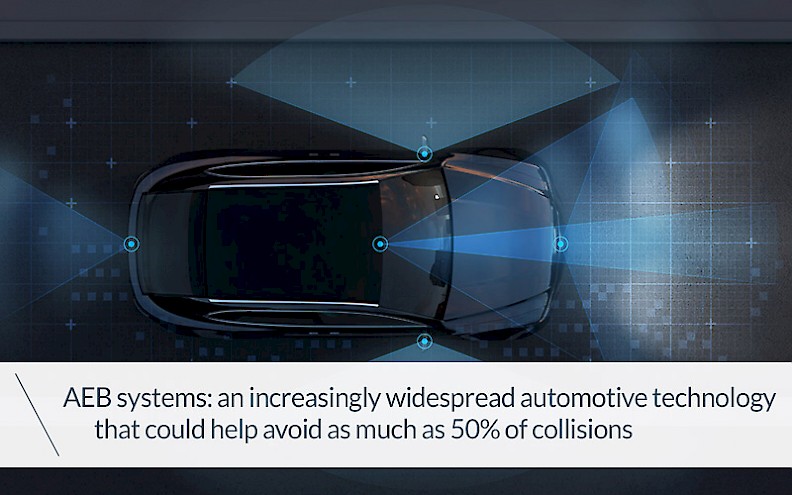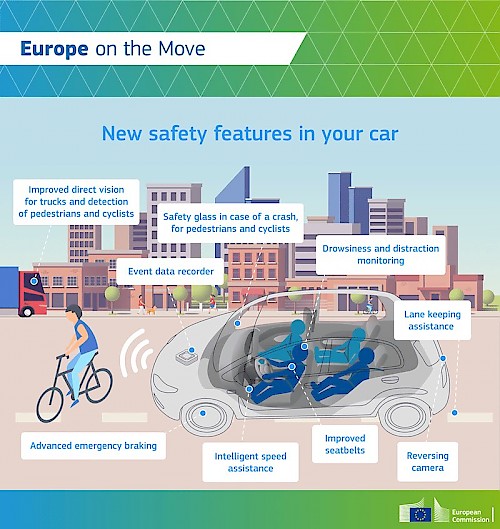AEB systems: an increasingly widespread automotive technology that could help avoid as much as 50% of collisions

The data published through the Global status report on road safety by the World Health Organization on car crashes are staggering: every year roughly 1.3 million people die in car accidents, and another 20-50 million are injured for the same reason.
Pedestrians, cyclists and bikers make up nearly half of the road victims, highlighting the necessity to ensure that these road users are a focus in road safety programs.
Indeed, UE institutions have reached a provisory political agreement on a revision for road safety laws in general, which means that as of 2020 it is compulsory to install new safety technologies in vehicles sold in Europe, to protect passengers, pedestrians, cyclists and bikers.

This infographic, issued as an information leaflet by the European Commission, details the new safety features that all vehicles sold in the EU will need to have; among the most interesting of these technologies there is the AEB (advanced emergency braking).
What is AEB?
AEB is a technology available in some new generation vehicles, which includes an advanced emergency braking system.
How does this technology work?
The AEB system is a highly effective active safety system for avoiding rear-end collisions, that is, crashes where rear bumpers are hit.
Generally speaking, this type of collision is typical on urban routes, where low speeds and close proximity are typical of traffic flows.
This system is designed to identify imminent collisions and react by automatically applying the brakes, and works through object recognition in the area in front of the car via a camera.
This video issued by the National Highway Traffic Safety Administration (USA) explains simply and clearly exactly what the technology is and why it is useful.
AEB can reduce accidents by up 50%
According to the UE, new technologies on the market can help to reduce the numbers of dead and injured on our roads, 90% of which are due to human error.
Over recent years, many studies have been conducted on the effects of AEB in collisions, highlighting an opportunity to reduce these by up to 50%.
The total number of collisions that can be reduced by AEB systems in different countries obviously varies, according to the differing nature of the types of road collision in each country.
Furthermore, it is evident that safety gains for any single country are tightly linked to the degree of market penetration of active safety systems.
On average, data show a range of reduction in accidents between 25% and 50%.
AEB City systems and AEB Inter-Urban systems
The vast majority of rear-end collisions occur, as we mentioned, in urban situations, due to distraction and bad judgement calls, and nearly always at low speeds.
Indeed, most of the vehicles that are fitted with AEB systems see such systems active only in situations where low speeds are involved. This does not mean, however, that there are no solutions able to cope with higher speeds.
Let’s differentiate between:
- AEB City Systems: systems that work at lower speeds
- AEB Inter-Urban Systems: systems that work at higher speeds
Generally, the sensors adopted are cameras, radar and lidar, sometimes used together. In AEB City systems, it is usually cameras or lidar that are adopted as sensors, while for Inter-Urban systems, the OEMS usually opt for a radar, together with a camera.
Today, the distinction between these two technologies is less evident, because the new-generation systems tend to work very well in both situations.
Moreover, besides recognizing a stationary vehicle ahead, the systems are also able to detect pedestrians and cyclists, thus avoiding accidents involving them, which can be very dangerous. The Euro NCAP test however, still evaluates the two applications separately.
AEB and automatic pilot systems
It is important to underline one fact: AEB systems do not completely substitute human involvement.
In fact, when driving a vehicle with AEB installed, full attention must be given at all times whilst at the wheel, as the emergency braking system does not work in all conditions and it's not always enough.
So, it is vital to stay alert whilst driving.
Having said this, those working in the sector have granted AEB systems with an “educational” role, in the sense that they are gradually preparing drivers to adopt automated driving systems, and to trust them.



